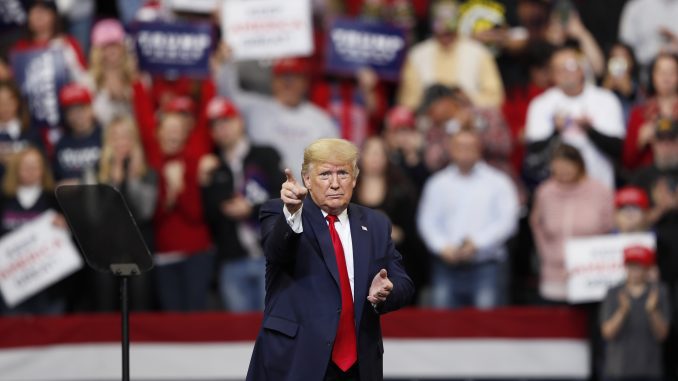
WASHINGTON, D.C. — President Donald Trump is offering a $4.8 trillion election-year budget plan that recycles previously rejected cuts to domestic programs like food stamps and Medicaid to promise a balanced budget in 15 years — all while leaving Social Security and Medicare benefits untouched.
Trump’s fiscal 2021 plan promises the government’s deficit will crest above $1 trillion only for the current budget year before steadily decreasing to more manageable levels, relying on optimistic economic projections, lower interest costs, scaled-back overseas military operations and proposed cuts to agency budgets that run counter to two separate budget deals signed by Trump.
The budget “sets the course for a future of continued American dominance and prosperity,” Trump said in a message accompanying the document.
“There is optimism that was not here before 63 million Americans asked me to work for them and drain the swamp,” Trump said. “For decades, Washington elites told us that Americans had no choice but to accept stagnation, decay, and decline. We proved them wrong. Our economy is strong once more.”
The plan had no chance even before Trump’s impeachment scorched Washington. Its cuts to food stamps, farm subsidies, Medicaid and student loans couldn’t pass when Republicans controlled Congress, much less now with liberal House Speaker Nancy Pelosi, D-Calif., setting the agenda.
Trump’s budget follows a familiar formula that exempts seniors from cuts to Medicare and Social Security while targeting benefit safety net programs for the poor, domestic programs like clean energy and student loan subsidies. It again proposes to dramatically slash funding for overseas military operations to save $567 billion over 10 years but adds $1.5 trillion over the same time frame to make his 2017 tax cuts permanent law.
Trump’s budget would also shred last year’s hard-won budget deal between the White House and Pelosi by imposing an immediate 5% cut to non-defense agency budgets passed by Congress. Slashing cuts to the Environmental Protection Agency and taking $700 billion out of Medicaid over a decade are also nonstarters on Capitol Hill, but both the White House and Democrats are hopeful of progress this spring on prescription drug prices.
On Capitol Hill, Democrats controlling the House have seen their number of deficit-conscious “Blue Dogs” shrink while the roster of lawmakers favoring costly “Medicare for All” and “Green New Deal” proposals has swelled.
The White House hasn’t done much to draw attention to this year’s budget release, though Trump has revealed initiatives of interest to key 2020 battleground states, such as an increase to $250 million to restore Florida’s Everglades and a move to finally abandon a multibillion-dollar, never-used nuclear waste dump that’s political poison in Nevada. The White House also leaked word of a $25 billion proposal for “Revitalizing Rural America” with grants for broadband Internet access and other traditional infrastructure projects such as roads and bridges.
The Trump budget also promises a $3 billion increase — to $25 billion — for NASA in hopes of returning astronauts to the moon and on to Mars. It touts a beefed-up, 10-year, $1 trillion infrastructure proposal, but $800 billion of that comes through existing surface transportation programs. It contains a modest parental leave plan championed by first daughter Ivanka Trump and includes $135 billion in savings over the coming decade as part of an unspecified set-aside to tackle the high cost of prescription drugs this year.
Trump’s U.S.-Mexico border wall would receive a $2 billion appropriation, more than provided by Congress but less than the $8 billion requested last year. Trump has enough wall money on hand to build 1000 miles (1,600 kilometers) of wall, a senior administration official said, most of it obtained by exploiting his budget transfer powers.
The reduced wall request could ease the way for action on appropriations bills in the GOP-held Senate, where a fight over last year’s far larger wall request stalled work on the annual spending bills for months.
Trump has proposed modest adjustments to eligibility for Social Security disability benefits, and he’s proposed cuts to Medicare providers such as hospitals, but the real cost driver of Medicare and Social Security is the ongoing retirement surge of the baby boom generation and health care costs that continue to outpace inflation.
With Medicare and Social Security largely off the table, Trump has instead focused on Medicaid, which provides care to more than 70 million poor and disabled people. President Barack Obama successfully expanded Medicaid when passing the Affordable Care Act a decade ago, but Trump has endorsed GOP plans to dramatically curb the program.
Trump’s latest Medicaid proposal, the administration official said, would allow states that want more flexibility in Medicaid to accept their federal share as a lump sum; for states staying in traditional Medicaid, a 3% cap on cost growth would apply. Trump would also revive a plan, rejected by lawmakers in the past, to cut food stamp costs by providing much of the benefit as food shipments instead of cash.
Other cuts, outlined in an annual “Major Savings and Reforms” volume, include eliminating heating subsidies for the poor and $405 million worth of grants to boost community service work by senior citizens, along with plans to dramatically slash legal aid to the poor, the National Endowment for the Arts, and subsidies to states such as California saddled with high costs for jailing criminal immigrants.



